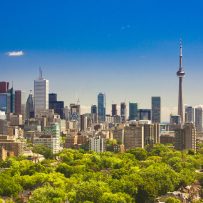INFRASTRUCTURE OR NON-PROFIT RENTAL BUILDINGS? HOW SHOULD TORONTO SPEND PROVINCE’S $114 MILLION HOUSING “REWARD”

Following the Ontario government recently “rewarding” the City of Toronto with $114 million for exceeding its Housing Action Plan targets by 51 per cent, conversations surrounding how the money should be spent have begun.
Beaches-East York Councillor Brad Bradford believes this newly available funding should go towards city infrastructure.
“There are a couple things the province outlined that we could do with the money, but we need to be investing this in the infrastructure to enable growth,” said Bradford.
Bradford told Beach Metro Community News that the city is in need of many upgrades and enhancements before it can be ready for the additional growth expected over the next decade.
“The reality is that with the amount of additional units we’re going to need (in order to) hit our housing targets over the next decade, we’re going to need to make major investments in infrastructure, sewer, water, transit, community centres – all that sort of stuff,” he said.
Although Bradford described the $114 million reward as “helpful”, he pointed out that in a city as demanding as Toronto this financing “doesn’t necessarily go that far”.
“At the end of the day, we need the (federal government) and the province to step up with some sort of sustainable infrastructure fund,” said Bradford.
WoodGreen Community Services, on the other hand, is hoping that the funding will be put towards the development of housing in a more direct manner.
In a Feb. 23 press release, the non-profit organization commended the provincial government for the recent investment into Toronto’s housing development and urged the city to invest in non-profits–like WoodGreen–that can utilize financing to secure more affordable units for the many residents in need of them.
“While we applaud these actions, much more still must be done to speed up and scale new affordable housing supply in Ontario and Toronto,” read the WoodGreen release.
WoodGreen’s demand comes with much community support as housing costs have skyrocketed, with homelessness simultaneously increasing at a steady pace.
City officials often point to the fact that more homes need to be built at a rapid pace to keep up with Toronto’s increasing population.
But with much of the new housing that Toronto is being rewarded for being condos that are for sale or being rented at high prices, critics of Ontario’s housing plan wonder if the city is in setting up newcomers for failure.
“I don’t know what percentage (of the new developments) are condos versus rentals because we don’t actually zone for type of tenure,” said Bradford. “What I can say is that for a long time, the condominium market has served as a pseudo-market here in Toronto because of tax law and the cost of building purpose-built rentals.”
Bradford said that conditions in the City of Toronto have made it “almost financially impossible” to develop purpose-built rentals even though the federal government has made long-term low cost financing for rental construction available to developers.
Still, WoodGreen is suggesting an Affordable Housing Equity Fund in the form of “upfront capital to launch feasible development plans for affordable housing projects”.
Toronto’s $114 million reward came from Ontario’s Building Faster Fund. The $1.2 billion provincial fund is part of a three-year program which aims to encourage municipalities to meet housing targets.
Toronto had a total of 31,656 housing starts “that includes 30,516 housing units”, according to the city. This has brought Toronto closer to its 2030 goal of creating 285,000 more new homes.
Story by: Beach Metro


